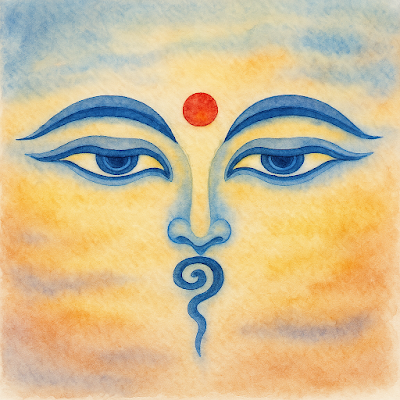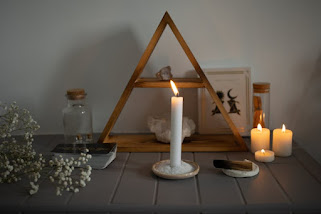Meditating on Sacred Symbols: A Beginner’s Guide
Have you ever felt drawn to a symbol, like the soothing curve of Om or the intricate beauty of a mandala, and wondered what it means? Maybe you’ve seen these shapes in yoga studios, on jewelry, or even in your dreams, sparking curiosity about their purpose. Chakra signs also play a vital role in meditation, helping achieve inner harmony and balance during spiritual practices. Meditating on sacred symbols is a powerful way to deepen your practice. It offers a bridge between the physical and spiritual worlds, blending focus with meaning in a way that’s surprisingly approachable.
For beginners, these symbols might seem mysterious or out of reach, but trust me, they’re not. Whether you’re chasing inner peace, sharper focus, or a connection to something bigger, this guide is here to light the way. In this beginner’s guide to meditating on sacred symbols, we’ll explore what they are, why they matter, and how you can start using them today with a simple step-by-step process. No experience needed, just an open mind.
Understanding Meditation Symbols
Meditation symbols are a significant part of various spiritual traditions, including Buddhism, Hinduism, and yoga. These symbols hold specific meanings and can be powerful tools in meditation practice, helping to elevate mindfulness, reach higher states of consciousness, balance chakras, and more.
Imagine sitting in a quiet room, focusing on a symbol like the Om or the Lotus flower. These aren’t just random shapes; they are steeped in history and spiritual significance. For instance, Buddhist monks often meditate on the Lotus flower, which represents enlightenment and purity. The Lotus grows in muddy water, yet it blooms beautifully, symbolizing how we can rise above our challenges and find clarity.
In Hinduism, the Om symbol is considered the sound of the universe, representing unity and creation. Chanting Om during meditation can help you feel connected to the world around you, grounding you in the present moment. It’s like tuning into a universal frequency that brings peace and harmony.
These symbols also play a crucial role in balancing chakras, the energy centers in our bodies. Each chakra has its own symbol and color, and meditating on these can help align your energy, promoting physical and emotional well-being. For example, focusing on the heart chakra symbol can foster love and compassion, while the third eye chakra symbol can enhance intuition and insight.
By incorporating meditation symbols into your practice, you can deepen your mindfulness and reach higher states of consciousness. They serve as focal points, helping you to quiet your mind and connect with your inner self. Whether you’re visualizing the symbol or chanting it, these sacred icons can transform your meditation experience, making it more profound and meaningful.
So, next time you sit down to meditate, consider using a symbol that resonates with you. It might just be the key to unlocking a deeper level of awareness and tranquility in your life.

What Are Sacred Symbols?
Sacred symbols are visual representations of deep spiritual truths, and they’ve been around for thousands of years. They show up in every corner of the world, from the Lotus flower in Buddhist temples to the Hamsa hand in Middle Eastern homes. These aren’t just pretty designs. They carry energy and meaning that go beyond words, speaking to something ancient inside us. The evil eye symbol, for instance, has been used across various religions like Judaism, Islam, Hinduism, and Buddhism, as well as in Greek and Roman traditions, as a protective talisman against negative attention and ill will from others. In meditation, sacred symbols for meditation become focal points. They help you quiet your busy mind and tap into a deeper awareness that’s hard to find in the chaos of daily life.
Think about the Egyptians and their ankh, a cross with a loop at the top symbolizing eternal life. Or the Hindus with Om, a sound and shape said to echo the universe itself. These cultures used symbols in rituals, art, and carvings to connect with the divine. I remember visiting a museum once and seeing an ankh etched into a stone tablet. It hit me how people thousands of years ago were using it to feel closer to something greater, just like we can today. That’s the beauty of it. Sacred symbols aren’t locked in the past. They’re tools for anyone wanting to enrich their spiritual practice, no matter where you’re coming from or what you believe.
Why Meditate on Sacred Symbols?
So, why bring symbols into your meditations? It’s a fair question, especially if you’re new to this. The answer is all about how they change your experience. Meditating on sacred symbols sharpens your focus by giving your mind a clear anchor. If you’re someone whose thoughts bounce around like a ping-pong ball (I’ve been there!), this can be a game-changer. Instead of wrestling with a blank mind, you’ve got something to hold onto.
But it’s more than just focus. These symbols stir emotions like calm, wonder, or inspiration, which can deepen your sense of peace. Take the Lotus flower, for instance. Picturing it blooming can feel like a quiet reminder that beauty can grow from tough places. On a spiritual level, using sacred symbols to deepen meditation can align your energy. They connect you to universal truths, like harmony or protection, or even personal intentions you set for yourself.
There’s some science behind this too. Research on mindfulness shows visual aids boost concentration, especially for beginners. Sacred symbols take it a step further by layering meaning into the mix. I’ve had friends tell me they feel lost meditating without a guide, but once they tried focusing on a mandala, it clicked. It’s like having a gentle hand steering you inward. That’s why these symbols are worth a try. They make meditation feel less daunting and more alive.

Top Sacred Symbols for Beginners
Ready to dive in? Here are five meditation symbols for beginners, each with a unique meaning and purpose. I’ve picked these because they’re simple to grasp yet packed with depth, perfect for starting out. These symbols can help harness personal power for transformation and growth.
1. Om (Aum)
•Meaning: The sound of the universe, symbolizing unity and creation. In Hinduism, it’s the first sound ever made, tying everything together.
•How to Use: Chant “Om” softly, letting the sound hum through you. Or picture its flowing shape, like a little wave of calm. I tried this once in a quiet room, and the vibration felt like it melted my stress away.
•Why It Works: That hum settles your nerves, grounding you fast. It’s a beginner favorite for a reason.
2. Lotus Flower
•Meaning: Enlightenment and purity, blooming from muddy waters. It’s a Buddhist staple, showing how we can rise above messiness. The Lotus Flower is represented as a symbol of enlightenment and purity, embodying these concepts deeply.
•How to Use: Imagine a lotus opening at your heart as you breathe. Picture its petals unfurling, slow and steady. I find it soothing to think of it growing through my worries.
• Why It Works: It represents growth, which resonates if you’re just starting your journey.
3. Mandala
•Meaning: A circular design that stands for harmony and the cosmos. Tibetans use them to map the universe in stunning detail.
•How to Use: Look at a mandala’s center, letting your eyes rest there. I’ve got a small one on my desk, and tracing its patterns pulls me right in.
•Why It Works: Its symmetry calms your mind, making it great for visual meditation.
4. Hamsa Hand
•Meaning: Protection and balance, often tied to chakra harmony. You’ll see it in jewelry or wall art across many cultures.
•How to Use: Picture its open palm shielding you while you breathe deeply. I imagine it pushing away distractions, like a quiet bodyguard.
•Why It Works: It brings a sense of safety, easing any beginner jitters about “doing it wrong.”
5. Buddha Eyes (Wisdom Eyes)
• Meaning: Awareness and spiritual awakening, found on Buddhist stupas in Nepal. Those curved lines and dots feel like they’re watching the world, connecting deeply with one’s spirit.
• How to Use: Visualize these eyes gazing over you, sparking insight. I like thinking they’re nudging me to notice more.
• Why It Works: It encourages mindfulness, a big win for anyone new to this. Understanding the meaning of sacred symbols in meditation helps you pick one that fits your goal. Want peace? Go for Om. Craving protection? Try the Hamsa. Play around and see what clicks.

How to Meditate on Sacred Symbols: A Step-by-Step Guide
New to meditation? Don’t worry, it’s easier than it sounds. Here’s how to meditate with symbols in five straightforward steps. I’ve kept it simple so you can start without overthinking it:
Set Your Space: Find a quiet spot where you won’t be interrupted. Lower the lights if you can, and sit comfortably, maybe on a cushion or chair. Place an image of your chosen symbol, like a printed mandala or a sketch of Om, in front of you. These symbols are represented as visual aids in meditation, helping to convey complex spiritual concepts and guide your practice. No image? No problem. Just hold it in your mind. I like lighting a candle sometimes to set the mood, but that’s optional.
Choose Your Symbol: Pick one that feels right for you today. Maybe Om if you’re after calm, or the Lotus if you want to feel growth. I switch mine up depending on how I’m feeling, and it keeps things fresh.
Focus Your Gaze or Mind: If you’ve got an image, look at it gently, not staring too hard. If you’re visualizing, close your eyes and see it clearly, like painting it in your head. I find it helps to soften my focus, almost like daydreaming.
Breathe and Connect: Inhale deeply for 4 counts, hold for 4, exhale for 4. As you breathe, feel the symbol’s energy. Picture Om’s hum vibrating in your chest or the Lotus unfolding with each breath. I messed this up at first, rushing it, but slowing down made all the difference.
Let Go: After 5 to 10 minutes, release the image and sit quietly. Notice how you feel, no pressure to “get it right.” I usually feel lighter, even if my mind wandered a bit.
This beginner’s guide to meditating on sacred symbols is flexible. Start with 5 minutes and build up when you’re ready. I stuck with short sessions for weeks before going longer, and it worked fine. Consistency beats perfection every time. If you’re nervous, just remember it’s your space to explore.
Common Questions About Sacred Symbol Meditation
Since you’re new to this, you might have some questions. I sure did when I started! Here are answers to a few common ones to ease your mind:
• Do I need to believe in a religion to use these symbols?
Nope! You don’t have to be Buddhist to love the Lotus or Hindu to chant Om. They’re universal tools. I’m not religious myself, but I still find them meaningful. Use them in a way that fits you.
• What if I can’t visualize well?
That’s okay. Not everyone sees vivid pictures in their mind. Try focusing on the symbol’s feeling instead, like the warmth of a Hamsa or the sound of Om. I struggled with this too, but leaning into the vibe worked better for me.
• Can I use more than one symbol at a time?
Sure, though I’d start with one to keep it simple. Once you’re comfy, mix them up. I’ve tried pairing a mandala with Om’s chant, and it felt like a double dose of calm.
• How do I know if I’m doing it right?
If you feel a shift, even a small one, you’re on track. There’s no perfect way. I used to worry about this, but letting go of “rules” made it more fun.
These questions pop up a lot, and they’re normal. Sacred symbol meditation is personal, so tweak it until it feels good for you.

Tips for Success as a Beginner
Here are some practical tips to make your journey smooth and enjoyable. I’ve learned these the hard way, so you don’t have to:
Start Small: Don’t aim for an hour right away. Five to ten minutes is plenty to begin. I tried jumping into long sessions and burned out fast. Short and steady wins here.
Don’t Overthink: If your mind drifts, just come back to the symbol. No big deal. I used to get frustrated, but now I see wandering as part of the process.
Experiment: Try different symbols to see what you like best. I bounced between the Lotus and Hamsa for weeks before settling on favorites.
Use Tools: A journal for your thoughts or some soft music can make it easier. I jot down how I feel after, and it’s cool to look back on. A little flute music helps me relax too.
Be Patient: Getting deeper takes time, so enjoy the ride. I didn’t feel “zen” overnight, but sticking with it built something real over time.
These tips keep your journey with sacred symbols simple and fun. It’s less about mastering it and more about exploring what works for you.
Conclusion
Meditating on sacred symbols is an easy yet meaningful way to kick off your spiritual practice. From the universal Om to the protective Hamsa, these icons open a path to peace and self-discovery that’s hard to beat. They’ve been around forever, helping people find calm and connection, and now they’re here for you too. With this beginner’s guide, you’ve got everything you need to get going. Pick a symbol that speaks to you, follow the steps, and see where it leads. It doesn’t have to be fancy or perfect, just yours. Why not give it a try today? Your inner calm is waiting, and I bet you’ll surprise yourself with how natural it feels.






